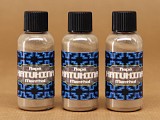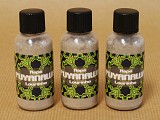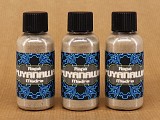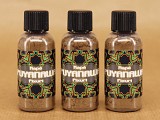Bottle, 10 Ml, 7 Gr from Brazil (SKU 3764)
(Batch #4536). This particular Rapé has an earthy, mildly sharp aroma that opens the senses and stimulates the body. Its grounding effects help one stay connected to the earth while spiritually uplifting, making it suitable for focused meditation, rituals, or social ceremonies. In traditional use, Murici ashes are not only a physical substance but are also believed to carry energetic properties, particularly in clearing and balancing energies in the body. The ashes are said to be especially effective at targeting areas of energetic blockage in the lower abdomen, promoting a healthy flow of energy through the solar plexus and sacral chakras. Detailed information can be found below.
Packed in 10 ml clear plastic bottles containing 7 gr.
The Puyanawa Murici Rapé incorporates handcrafted Corda Tabaco and the revered ashes from the Murici tree (Byrsonima crassifolia). This blend represents the deep connection the Puyanawa people have with their natural surroundings and spiritual traditions. The Murici tree is abundant in the Amazonian forest and holds a prominent place in both the ecology and the spiritual practices of the Puyanawa tribe. The tree produces a highly prized fruit, which is not only a source of food for many forest animals but also has spiritual and medicinal significance for the people.
In Puyanawa culture, Murici Rapé is believed to have restorative properties, particularly known for combating fatigue and maintaining spiritual vitality. It is often associated with the joy and warmth of celebrating with friends, embodying a sense of unity and shared connection. This makes the Murici Rapé a perfect choice for ceremonies or moments of reflection in communal settings, as its energetic and uplifting effects align with the idea of social harmony and collective spirit.
The Murici tree belongs to the Malpighiaceae family and is native to regions in South and Central America, including the Amazon, Mexico, and the Caribbean. Its use dates back to pre-Columbian times, where it played a significant role in the traditional medicine of indigenous tribes. The fruits of the Murici tree, known for their tart flavor, are consumed locally, and the bark, leaves, and roots of the tree are used in various traditional remedies.
In folk medicine, Murici has been used for treating digestive ailments, respiratory issues, and even skin problems. More importantly, the ashes of the Murici tree, when used in sacred snuffs like Rapé, are believed to have powerful spiritual cleansing properties. The Puyanawa and other indigenous groups believe that these ashes help clear negative energies, particularly those that accumulate in the lower abdomen, an area often associated with emotional blockages and stress.
Corda Tabaco, a traditional Nicotiana Rustica variety, is carefully chosen for this Rapé blend. The Tabaco undergoes a hands-on craftsmanship process, where the leaves are rolled and twisted into dense ropes and then fermented, creating a Tabaco rich in nicotine and deeply grounded in its natural essence. Combined with Murici tree ashes, the resulting blend offers a unique experience, both powerful and cleansing.
This particular Rapé has an earthy, mildly sharp aroma that opens the senses and stimulates the body. Its grounding effects help one stay connected to the earth while spiritually uplifting, making it suitable for focused meditation, rituals, or social ceremonies.
In traditional use, Murici ashes are not only a physical substance but are also believed to carry energetic properties, particularly in clearing and balancing energies in the body. The ashes are said to be especially effective at targeting areas of energetic blockage in the lower abdomen, promoting a healthy flow of energy through the solar plexus and sacral chakras. This clearing effect is thought to help alleviate stress and emotional imbalances, allowing individuals to feel more centered and aligned with their surroundings.
The Puyanawa people have long used Rapé as a tool for spiritual connection and healing. In ceremonies, the Rapé is blown into the nostrils, allowing the spirit of the Tabaco and the ashes to work on a deep, energetic level. Murici Rapé, in particular, is valued for its ability to anchor the user while providing a subtle energizing effect that enhances clarity and spiritual focus. Its association with the joy of friendship makes it a versatile Rapé, suitable for both personal introspection and communal bonding.
We take great care to reprocess all received stock to ensure the finest quality powder. Often, Rapé arrives with varying levels of fineness due to the lack of professional sieves used by the tribe. To address this, we meticulously sieve all powders to remove rough bits and particles, resulting in an exceptionally smooth and effective powder at 150-micron fineness. We use laboratory-grade sieves and dehydrating equipment to achieve this quality. This is our standard because it provides the best Rapé experience.
Other names: Corda Murici
Like many peoples of Acre, the Puyanawa tribe suffered heavily from the boom in rubber and caucho extraction in the region at the start of the 20th century. Since the first contacts with non-Indians, many have died in direct confrontations or from diseases contracted during the colonization process. The survivors were forced to work in the rubber extraction areas – the Seringais – and quickly found their way of life decimated due to the methods used by the ‘rubber barons’ to keep the Indians working under their yoke. The Puyanawa were expelled from the lands, missionised and education in schools that banned any expression of any trace of their culture. It was only with the beginning of the process of demarcating their territory that Puyanawa culture was once again valued by the Indians themselves, who have worked hard to recuperate their native language, a difficulty task given the small number of speakers left.
Facial tattoos are common to various Pano-speaking peoples. The priest Tastevin reported at the start of the 20th century that the tattoos among the Puyanawa comprised a line extending from the mouth to the ear lobe with small vertical lines over the main line. There was a blue colour over the tattoo and around the laps. The tattoos were applied to children aged between eight and ten years, generally by elders. In the 1980s, there were still three Puyanawa Indians with facial tattoos. Other information also recorded in the 1980s relates that during this period only the old people knew how to make baskets, bows and arrows, body adornments, sleeping hammocks and clay pots. The latter objects were manufactured for domestic and religious purposes. In the past there was a container designed to “cook the dead.” According to Tastevin, the Puyanawa cooked the corpses of the dead for ten to twelve hours, dancing and crying. The leader divided the pieces of flesh of the deceased between the kin and other Indians taking part in the ritual. These recipients incinerated the pieces of flesh and mixed the ashes with caiçuma (a maize drink with peanuts), which were then ingested with the objective of incorporating the qualities of the deceased.
At the start of the 20th century, the Puyanawa inhabited the headwaters of the affluents of the lower Moa River. After the contact with non-Indians, they were forced to live on lands belonging to a prominent farmer from the region, Colonel Mâncio Agostinho Rodrigues Lima. The Puyanawa live in two villages, Barão do Rio Branco and Ipiranga, situated in the municipality of Mâncio Lima no Acre. The main access route is the road, usable all year round. The distance between the centre of the Ipiranga rubber settlement and the town of Mâncio Lima is 28 km. The other option for accessing the area is via the Moa River.
Puyanawa subsistence is strongly based on agriculture. Each nuclear family owns a swidden, producing mainly for family consumption. They plant intercropped manioc and maize, as well as Peruvian beans, seven-week white mudubim and arigó, which are also intercropped with manioc. Rice, banana and sugar cane are grown separately. Reflecting the influence of regional society, some coffee bushes are also planted. Integrated with the regional economy, they sell flour, chickens, eggs and pigs via the region’s commercial system, i.e. to intermediaries of Cruzeiro do Sul or settlements close to the Puyanawa community, acquiring clothing, salt and other produce in exchange. Still in relation to trade, rubber continues to be a product sold in the region. Fishing, on the other hand, no longer comprises a perennial source of food, nor game, which information suggests has been almost non-existent since the 1970s. In addition, the Puyanawa also practice a number of activities surviving from their ancestral culture intended to maintain their welfare, trekking by foot over a wide and varied area to obtain game, water, wild fruits, raw material to make their very small range of craftwork, clay for pottery, bamboo for arrow shafts and so on.
The year 1988 saw the emergence of the first indigenous associations in the state of Acre, including the Poyanawa Agroextractivist Association of the Barão and Ipiranga (AAPBI). Two years after its foundation, the Puyanawa demarcated their land with funds obtained by their leaders on a trip to the United Kingdom. The initiative, which was not officially recognized by FUNAI, was fundamental to mobilizing the community, legitimizing the Puyanawa territory in the regard of the regional population and preventing the invasions by hunters that had been occurring until then. In the 1990s, the AAPBI was involved in various projects generating income for the community. It received financial support to fund part of the flour production sold to large buyers in Cruzeiro do Sul. However, the end of this project coincided with the disintegration of the local cooperative. The Association also administered a project for breeding and selling small livestock and from 1997 to 1999 developed a project centred on the purchase of a tractor and implements with the aim of mechanizing agricultural activities, reusing the areas of secondary growth and avoiding the need to clear areas of native forest.
In 1999, the AAPBI signed a service provision contract with the UNDP (United Nations Development Program) and PPTAL (Integrated Project for the Protection of the Indigenous Populations and Lands of Legal Amazonia) for the implementation of the “Subproject for Monitoring and Consolidating the Physical Demarcation of the Poyanawa Indigenous Land.” The project’s aim was to enable the Puyanawa and their Association to monitor the demarcation of their land, undertaken by a topography company hired by FUNAI in the first half of 2000. The Association was also responsible for putting up signs at more vulnerable points of the border paths in order to warn hunters, anglers and loggers that entry into the area is prohibited. The project enabled the institutional strengthening of the APPBI. Its directorship and the various work teams received courses in accountancy, office administration, use of GPS equipment and record making. To support the work of the AAPBI, both permanent and consumable material items were purchased for the new head office in Ipiranga village, as well as a boat to provide support to the demarcation work and enable surveillance and fiscalization of the indigenous territory. The Association publicized the demarcation through radio programs, newspaper reports and visits to nearby farmers, associations of indigenous peoples and rubber tappers, trade unions and government bodies based in Mâncio Lima and Cruzeiro do Sul. Since demarcation and homologation of the IL, the Puyanawa have demanded more commitment from the relevant government entities to prevent the continuing invasions and illegal occupations.
This item is not allowed in the following countries:
Finland
This natural product is offered for its ethnographic and historical value and is delivered with no expressed or implied fitness for a specific purpose. It is simply a raw botanical specimen, or a scientific sample. The information provided is purely meant for historical, scientific and educational purposes and should never be interpreted as a recommendation for a specific use. The use and application of our product is at the customer's decision, responsibility and risk.
Read our Terms & Conditions for more details.




